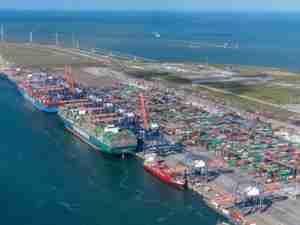“We had thought we would have to wait for 2009 to be able to report a six-figure annual throughput figure but the arrival of Maersk Line on 1 December changed all that.
“Maersk Line has brought not just an increase in vessel calls but also more road vehicle movements through the gate and increased rail traffic at the terminal’s dedicated rail facility. We are busier in every department and have been recruiting and training new staff for some months now. I am pleased to say though that our operations have continued to run smoothly.”
Much of the Maersk Line volume is moving on the company’s dedicated weekly Bremerhaven – DCT Gdansk feeder service. Maersk also works closely with Team Lines, an established DCT Gdansk customer, and consequently the number of Team Lines’ calls has also increased during December.
According to Peter Hildebrandt Nielsen, Managing Director of Maersk Polska, DCT Gdansk has performed very well during the first month:
“Both our own dedicated vessel and those of our feeder partner Team Lines have been handled with great efficiency. DCT has consistently achieved over 30 container moves per crane hour and all vessels have departed on or ahead of schedule.
“Thanks not only to DCT Gdansk’s own personnel but also to Customs and other authority bodies within the Port of Gdansk, administrative procedures have been conducted smoothly, resulting in several positive comments from our customers."
As more containers are now moving over DCT Gdansk to/from distant inland locations within Central and Eastern Europe, the terminal operator has been able to increase the number and frequency of rail services it offers. These trains have been well supported and more are promised.
DCT Gdansk’s General Manager, Fred Kamperman, paid tribute to his colleagues’ performance:
“For our operators to handle over 1,000 moves per vessel was a challenge but they proved more than equal to the task. Our equipment fleet has been boosted by the addition of three new Liebherr rubber-tired gantry cranes (RTGs) and ancillary machines, which has required more people. New recruits have included Poland’s first female RTG drivers who are already performing well.”










